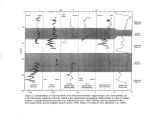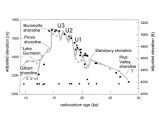| OCR Text |
Show 2 Plots of biotite and carbonate abundance over the entire length of the core closely mimic the marine oxygen isotopic record. That record reflects the variation in global ice volume over the last few million years, and the close correspondence of the Owens Lake proxies to the marine record suggests that the climate in the eastern Sierra Nevada region responded to global forcings, specifically the 20, 40 and 100 ka cycles in Earth's orbital parameters. However, fluctuations in Owens Lake parameters are not synchronous with variations in marine carbonate 8lsO, with events in the marine record occurring either earlier or later than similar events in the Owens Lake records. This lack of synchroneity may reflect either error in the chronologies of core OL- 92 and/ or the marine record, or may be due to inherent leads or lags in the climate system. Inasmuch as the marine carbonate 5180 reflects global ice volume, whereas Owens Lake carbonate abundance reflects the amount of precipitation in the Sierra Nevada region and biotite abundance reflects glacial activity in those mountains, we might not expect variations to be perfectly synchronous. Subsequent to the initial study, core OL- 92 was resampled at a higher resolution ( 70- cm- long channel samples each representing - 1500 years of sedimentation) back to 155 ka ( Menking et al., 1997; Bischoff et al., in press). Sediment grain size and clastic geochemistry, carbonate content, and stable isotopes record many oscillations representing changes in lake level and extent of Sierran glaciers. To first order, the records match well the marine 8180 record. At Owens Lake, however, the last interglaciation appears to span the entire period from 50 to 120 ka, according to our chronology, and was punctuated by numerous short periods of wetter conditions during an otherwise dry climate. Sediment proxies reveal that the apparent timing of glacial- interglacial transitions, notably the penultimate one, is proxy- dependent. In the grain- size and carbonate- content records this transition is abrupt and occurs at - 120 ka. In contrast, in the isotopic records the transition is gradual and occurs between - 120 and 145 ka. Differences in timing of the transition are attributable to variable responses by proxies to climate change. |

































































































































































